EDIT
In case you need it - I edited in a simplified wrapper for ease of use (just add commands in your
view-model)
Approach #2 - using Global Mouse Hook to track mouse move - the rest is similar to #1.
Actually, this is more of an example on how to do a global hook from C#.
In XAML you can hook up all 3 or just one, two events
my:Hooks.EnterCommand="{Binding EnterCommand}"
my:Hooks.LeaveCommand="{Binding LeaveCommand}"
my:Hooks.MouseMoveCommand="{Binding MoveCommand}"
In your view-model define commands
RelayCommand _enterCommand;
public RelayCommand EnterCommand
{
get
{
return _enterCommand ?? (_enterCommand = new RelayCommand(param =>
{
var point = (Point)param;
test1.Content = "Mouse entered";
// test2.Content = point.ToString();
},
param => true));
}
}
And the attached properties (the 'nice' wrapper)...
public static class Hooks
{
private static Dictionary<ContentControl, Action> _hash = new Dictionary<ContentControl, Action>();
#region MouseMoveCommand
public static ICommand GetMouseMoveCommand(ContentControl control) { return (ICommand)control.GetValue(MouseMoveCommandProperty); }
public static void SetMouseMoveCommand(ContentControl control, ICommand value) { control.SetValue(MouseMoveCommandProperty, value); }
public static readonly DependencyProperty MouseMoveCommandProperty =
DependencyProperty.RegisterAttached("MouseMoveCommand", typeof(ICommand), typeof(Hooks), new UIPropertyMetadata(null, OnMouseMoveCommandChanged));
static void OnMouseMoveCommandChanged(DependencyObject depObj, DependencyPropertyChangedEventArgs e)
{
ContentControl control = depObj as ContentControl;
if (control != null && e.NewValue is ICommand)
SetupMouseMove(control);
}
static void Instance_MouseMoveLL(object sender, WinHook.MouseLLMessageArgs e)
{
}
static void OnAutoGeneratingColumn(ICommand command, object sender, DataGridAutoGeneratingColumnEventArgs e)
{
if (command.CanExecute(e)) command.Execute(e);
}
#endregion
#region EnterCommand
public static ICommand GetEnterCommand(ContentControl control) { return (ICommand)control.GetValue(EnterCommandProperty); }
public static void SetEnterCommand(ContentControl control, ICommand value) { control.SetValue(EnterCommandProperty, value); }
public static readonly DependencyProperty EnterCommandProperty =
DependencyProperty.RegisterAttached("EnterCommand", typeof(ICommand), typeof(Hooks), new UIPropertyMetadata(null, OnEnterCommandChanged));
static void OnEnterCommandChanged(DependencyObject depObj, DependencyPropertyChangedEventArgs e)
{
ContentControl control = depObj as ContentControl;
if (control != null && e.NewValue is ICommand)
SetupMouseMove(control);
}
#endregion
#region LeaveCommand
public static ICommand GetLeaveCommand(ContentControl control) { return (ICommand)control.GetValue(LeaveCommandProperty); }
public static void SetLeaveCommand(ContentControl control, ICommand value) { control.SetValue(LeaveCommandProperty, value); }
public static readonly DependencyProperty LeaveCommandProperty =
DependencyProperty.RegisterAttached("LeaveCommand", typeof(ICommand), typeof(Hooks), new UIPropertyMetadata(null, OnLeaveCommandChanged));
static void OnLeaveCommandChanged(DependencyObject depObj, DependencyPropertyChangedEventArgs e)
{
ContentControl control = depObj as ContentControl;
if (control != null && e.NewValue is ICommand)
SetupMouseMove(control);
}
#endregion
static void SetupMouseMove(ContentControl control)
{
Action onmove;
if (_hash.TryGetValue(control, out onmove) == false)
{
onmove = () =>
{
var entered = false;
var moveCommand = control.GetValue(Hooks.MouseMoveCommandProperty) as ICommand;
var enterCommand = control.GetValue(Hooks.EnterCommandProperty) as ICommand;
var leaveCommand = control.GetValue(Hooks.LeaveCommandProperty) as ICommand;
// hook is invoked on the 'caller thread' (i.e. your GUI one) so it's safe
// don't forget to unhook and dispose / release it, handle unsubscribe for events
WinHook.Instance.MouseMoveLL += (s, e) =>
{
Point point = control.PointFromScreen(new Point(e.Message.Pt.X, e.Message.Pt.Y));
if (moveCommand != null && moveCommand.CanExecute(point))
moveCommand.Execute(point);
var newEntered = control.IsMouseInBounds(point); // don't use 'IsMouseOver'
if (newEntered != entered)
{
entered = newEntered;
if (entered)
{
if (enterCommand != null && enterCommand.CanExecute(point))
enterCommand.Execute(point);
}
else
{
if (leaveCommand != null && leaveCommand.CanExecute(point))
leaveCommand.Execute(point);
}
}
};
};
control.Loaded += (s, e) => onmove();
_hash[control] = onmove;
}
}
private static bool IsMouseInBounds(this ContentControl control, Point point)
{
var client = ((FrameworkElement)control.Content);
Rect bounds = new Rect(0, 0, client.ActualWidth, client.ActualHeight);
return bounds.Contains(point);
}
}
And you could use HookManager from the article.
Or the minimal hook code (mind that proper IDisoposable is required, exception handling etc.):
public sealed class WinHook : IDisposable
{
public static readonly WinHook Instance = new WinHook();
public const int WH_MOUSE_LL = 14;
public const uint WM_MOUSEMOVE = 0x0200;
public delegate void MouseLLMessageHandler(object sender, MouseLLMessageArgs e);
public delegate int HookProc(int nCode, IntPtr wParam, IntPtr lParam);
[DllImport("kernel32.dll", ExactSpelling = true, CharSet = CharSet.Auto)]
public static extern int GetCurrentThreadId();
[DllImport("user32.dll", CharSet = CharSet.Auto, CallingConvention = CallingConvention.StdCall, SetLastError = true)]
public static extern int SetWindowsHookEx(int idHook, HookProc lpfn, IntPtr hInstance, int threadId);
[DllImport("user32.dll", CharSet = CharSet.Auto, CallingConvention = CallingConvention.StdCall, SetLastError = true)]
public static extern bool UnhookWindowsHookEx(int idHook);
[DllImport("user32.dll", CharSet = CharSet.Auto, CallingConvention = CallingConvention.StdCall, SetLastError = true)]
public static extern int CallNextHookEx(int idHook, int nCode, IntPtr wParam, IntPtr lParam);
[DllImport("kernel32.dll", CharSet = CharSet.Auto)]
public static extern IntPtr GetModuleHandle(string lpModuleName);
[StructLayout(LayoutKind.Sequential)]
public struct POINT
{
public int X;
public int Y;
}
[StructLayout(LayoutKind.Sequential)]
public class MouseLLHookStruct
{
public POINT Pt;
public uint mouseData;
public uint flags;
public uint time;
public uint dwExtraInfo;
}
public class MouseLLMessageArgs : EventArgs
{
public bool IsProcessed { get; set; }
public MouseLLHookStruct Message { get; private set; }
public MouseLLMessageArgs(MouseLLHookStruct message) { this.Message = message; }
}
static IntPtr GetModuleHandle()
{
using (Process process = Process.GetCurrentProcess())
using (ProcessModule module = process.MainModule)
return GetModuleHandle(module.ModuleName);
}
public event MouseLLMessageHandler MouseMoveLL;
int _hLLMouseHook = 0;
HookProc LLMouseHook;
private WinHook()
{
IntPtr hModule = GetModuleHandle();
LLMouseHook = LowLevelMouseProc;
_hLLMouseHook = SetWindowsHookEx(WH_MOUSE_LL, LLMouseHook, hModule, 0);
if (_hLLMouseHook == 0) { } // "failed w/ an error code: {0}", new Win32Exception(Marshal.GetLastWin32Error()).Message
}
public void Release()
{
if (_hLLMouseHook == 0) return;
int hhook = _hLLMouseHook;
_hLLMouseHook = 0;
bool ret = UnhookWindowsHookEx(hhook);
if (ret == false) { } // "failed w/ an error code: {0}", new Win32Exception(Marshal.GetLastWin32Error()).Message
}
public int LowLevelMouseProc(int nCode, IntPtr wParam, IntPtr lParam)
{
if (nCode >= 0 && lParam.ToInt32() > 0
&& wParam.ToInt32() == (int)WM_MOUSEMOVE)
{
MouseLLHookStruct msg = (MouseLLHookStruct)Marshal.PtrToStructure(lParam, typeof(MouseLLHookStruct));
MouseLLMessageArgs args = new MouseLLMessageArgs(msg);
if (MouseMoveLL != null)
MouseMoveLL(this, args);
if (args.IsProcessed)
return -1; // return 1;
}
return CallNextHookEx(_hLLMouseHook, nCode, wParam, lParam);
}
// implement IDisposable properly and call `Release` for unmanaged resources / hook
public void Dispose() { }
}
Note: global mouse hooks are notorious for performance issues. And you cannot use the local one (recommended but most of the time useless) - as it doesn't get outside mouse moves.
Also avoid putting anything 'heavy' inside the event - or anything that 'spawns off' from it. There is a limit actually on the time you can spend processing the event - or your hook will get removed, i.e. stop working. If you need to do some processing from the event, pop up a new thread and Invoke back.
My favorite solution is actually to give the hook its own thread and then events need to be invoked - but that's out of scope and a bit more complex (you need a 'pump' in there etc.).
As to 'why' all this is necessary:
I don't like speculating, but seems that events are throttled - and the critical 'one' is missed when 'crossing the border', something like that. Anyway, it's all about the mouse moves no matter how you look at it.

